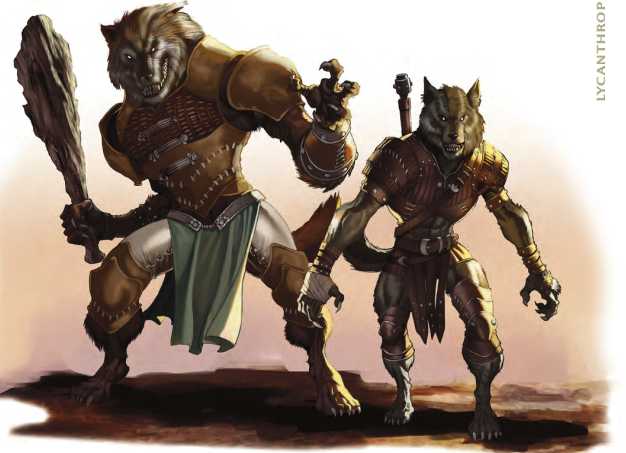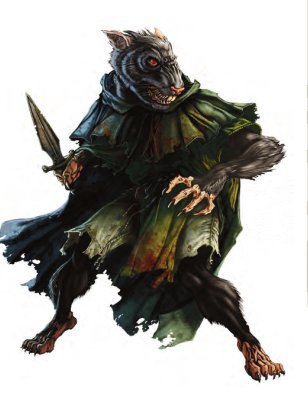Let's Read the 4e Monster Manual/Vault: Lycanthrope

Lycanthropes have always been a part of D&D, which apparently took inspiration from a mix of Holywood horror movies and a bit of traditional folklore. They are present in both the Monster Manual and the Vault.
The Lore

Lycanthropes are creatures who can change their shape to that of a humanoid, an animal, or a bipedal, animal-headed hybrid. There are different species, each associated with a specific animal. Contrary to popular myth, lycanthropy cannot be spread via bites, nor are lycanthropes forced to transform in the full moon.
If I understand it correctly, a lycanthrope is more like an animal who happens to be able to change into a human than the reverse. Many don’t feel comfortable living for an extended time in human society, and fear discovery of their true nature. They can reproduce normally with each other or with their related animal, unions which always result in new lycanthropes. They can also reproduce with humans, though in these cases their offspring is more likely to consist of “shifters” who can’t transform completely (and were introduced as a playable race in Eberron).
Villainous lycanthropes are the type that treats sapients as prey and who use their shapeshifting to infiltrate polite society and gnaw at it from within. The Monster Vault once again tells us all lycanthropes are like that. Guess it was ghostwritten by that bigot Volo.
The myths about the bite do have a shred of truth to them, as the bite of some lycanthropes can infect humanoid victims with diseases that might make them behave in an erratic or “bestial” way.
The Numbers
Both books give us stats for the two types of lycanthrope most likely to fight adventurers: wererats and werewolves.
In all cases their signature lycanthrope trait is the ability to change shape! They can use a minor action to switch between their human, animal or hybrid forms. As humans, they can use weapons. As animals, they can bite (and possibly spread disease). As hybrids, they can do both!
Lycanthropes also have Regeneration 5, which is disabled for a turn when they take damage from silver weapons. Due to the way regeneration works in 4e, you can kill them without silver, it’s just harder.
Wererat (MM)
Wererats are likely to be the first lycanthrope your PCs encounter, and also the ones most comfortable with living in civilization. Wererat thieves’ guilds are a classic staple of D&D.
Here they’re Medium Natural Humanoids with the Shapechanger keyword, and Level 3 Skirmishers with 48 HP. They also have the common traits listed above. They run at speed 6 and can climb at speed 4 in their non-human forms.
Wererats fight with short swords and bites. The bites do a little less damage but also do ongoing damage (save ends) and spread filth fever.
Wererats gain bonus “sneak attack” damage if they attack with combat advantage.
Filth Fever is a level 3 disease. Stage 1 makes you lose a healing surge, Stage 2 also inflicts -2 to all your defenses, and Stage 3 keeps the penalty and takes away all your healing surges and your ability to regain hit points. 4e disease rules have you make periodic Endurance checks to see if you worsen, improve or stay stable. Also I think you cannot recover on your own when you reach Stage 3.
Scurrying Wererat (MV)
This is much like the MM version, though its attacks are different.
This wererat’s weapon is a dagger, which does extra damage with combat advantage. Their bite deals ongoing damage with combat advantage (save ends).
The Vault also specifies someone bitten by a wererat must roll at save at the end of the fight to see if they contracted filth fever or not. The disease’s effects are the same.
As a move action while in rat form, this wererat can use Rat Scurry to shift its speed.
Frenzied Werewolf (MV)
Werewolves are the most classic lycanthropes and likely the first to be statted up for D&D.
This one is a Level 6 Brute with 78 HP and all common lycanthrope traits. It runs at speed 6, or 8 while in wolf form. Its weapon is a club, and both it and its claws do extra damage against bloodied targets. They can also bite, and bitten victims contract Moon Frenzy if they fail a save at the end of the fight.
In hybrid form, the werewolf can use Lycanthrope Fury to make both a claw and a bite attack as a standard action, dealing 5 damage to itself in the process.
Moon Frenzy is a level 6 disease. It doesn’t turn you into a werewolf, but it penalizes your Will (Stage 1) and forces you to attack a nearby ally when you become bloodied (Stage 2) and later on whenever you’re hit by an attack (Stage 3).
Werewolf (MM)
This one is quite similar to its Monster Vault counterpart, but is level 8 with 108 HP, lacks claws and Lycanthrope Fury and transmits a level 8 version of Moon Frenzy.
It’s worth noting that disease DCs are 3-4 points higher in the Monster Manual versions. I guess they must have been lowered by the time the Vault was published when the authors realized very few PCs ever trained Endurance.
Sample Encounters and Final Impressions
We get two in the Manual:
-
Level 4: 2 wererats, 4 dire rats, 6 human rabble. Your typical wererat thief gang.
-
Level 9: 4 werewolves, 4 dire wolves. A pack with extra punch.
The gothic/Holywood werewolf afflicted by a curse that turns then into ravenous murderers on the full moon is a classic… but that’s not what we get here at all. These lycanthropes are just another sapient species, and while there’s nothing preventing some individuals from turning to evil, there’s nothing compelling them to do so anyway (despite all the stat blocks we’re given being Evil).
This makes the Monster Vault’s more aggressive stance feel like vile bigotry to me. If you take it at face value you can say the Church of the Silver Flame was right to genocide lycanthropes and shifters in Eberron, which to me is a clue to not take it at face value.